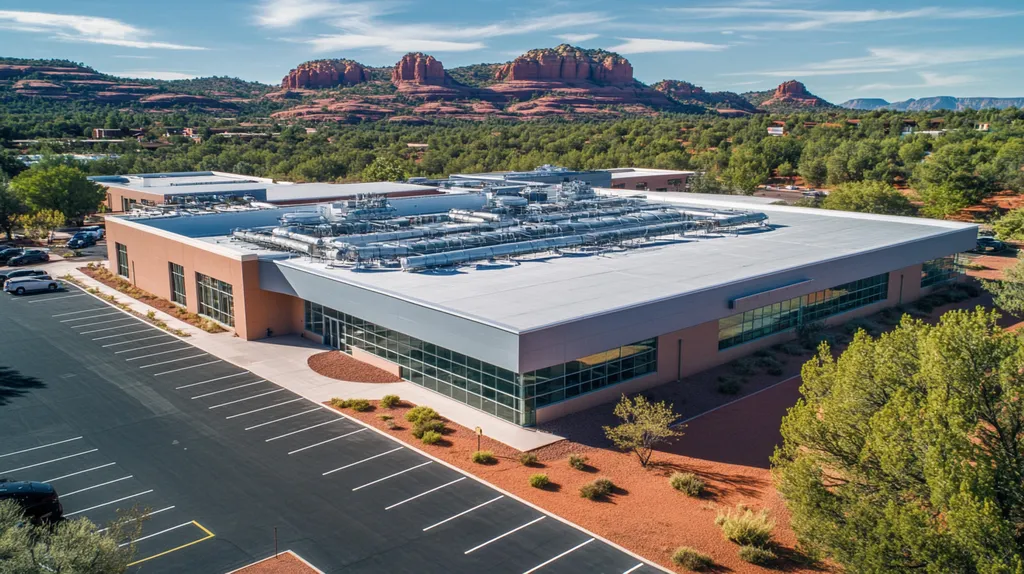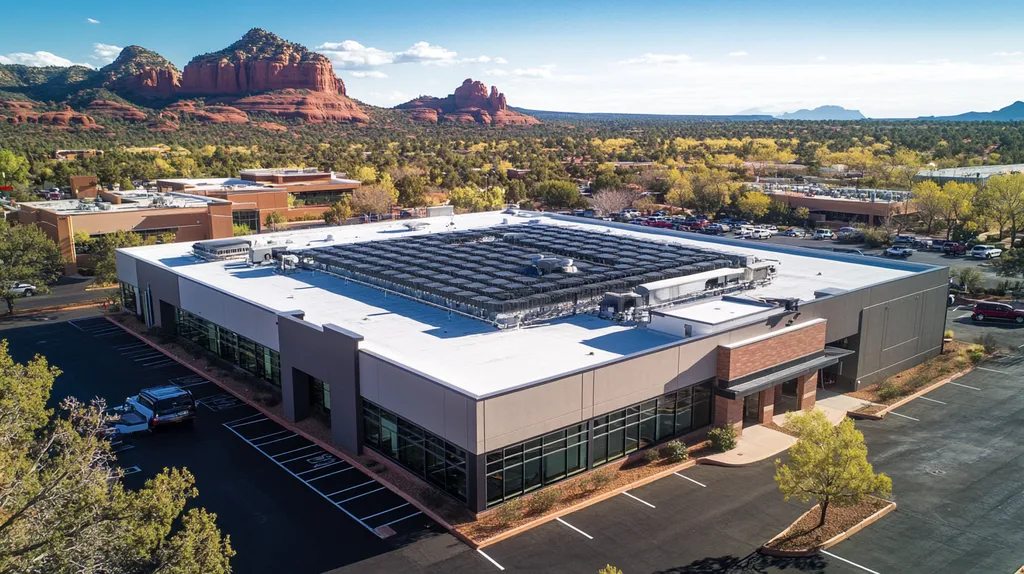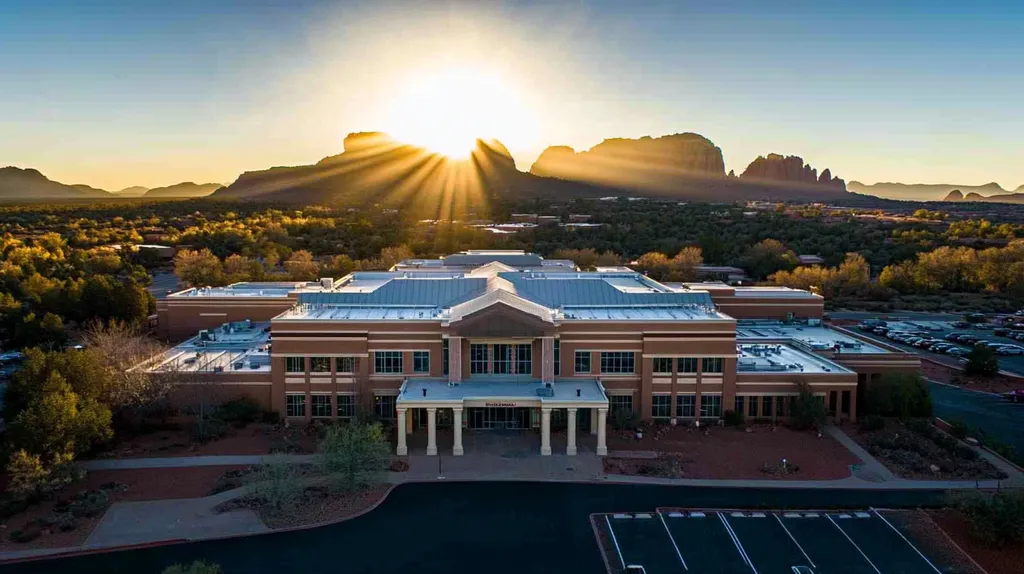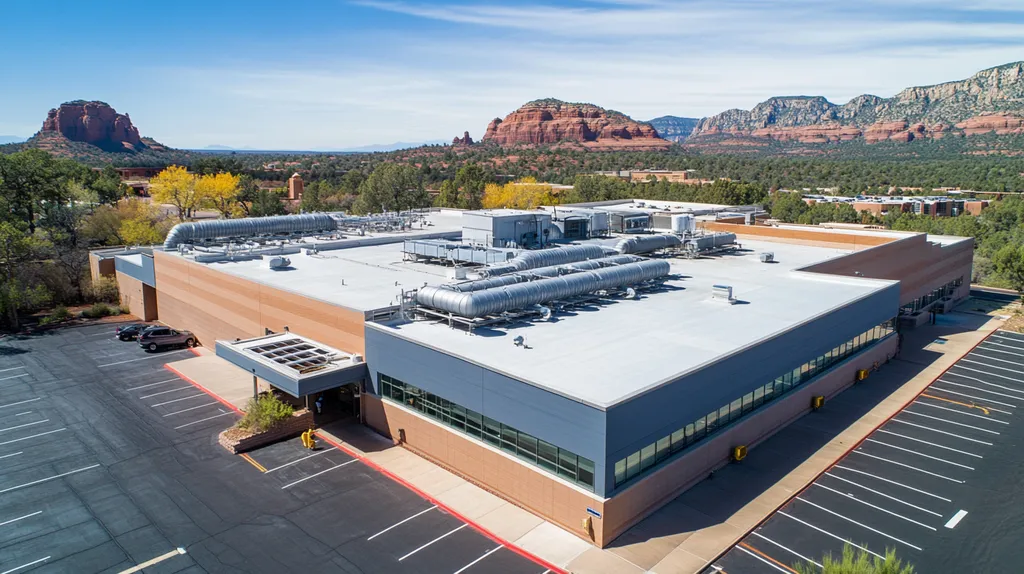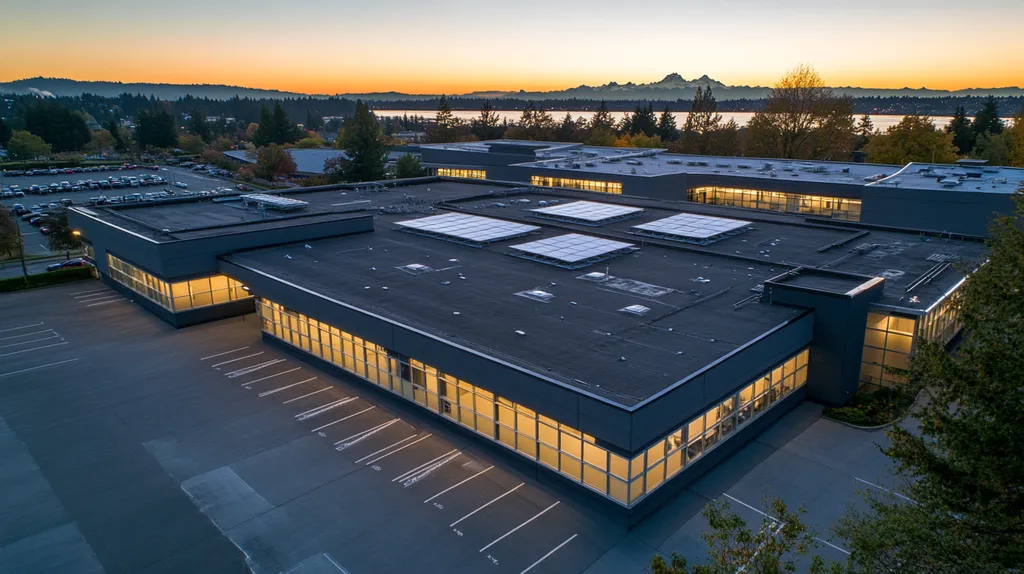In industrial roofing, moisture damage costs facilities over $3.7 billion annually in unnecessary repairs and premature replacements. Yet most building owners continue relying on outdated detection methods that miss up to 70% of developing moisture problems.
The stakes go far beyond simple leak repair. Hidden moisture can slash insulation effectiveness by 40%, compromise structural integrity, and trigger catastrophic failures that threaten both operations and safety.
This article cuts through common myths and marketing hype to deliver evidence-based strategies for moisture detection that actually work. We’ll examine why traditional assessment methods fail and explore proven alternatives that can prevent moisture-related disasters.
SECTION 1: COMMON MISCONCEPTIONS
When it comes to moisture damage in industrial roofs, myths and misconceptions don’t just waste money – they can literally bring the roof down. While fancy marketing pitches promise miracle solutions and quick fixes, the reality is that moisture assessment requires a sophisticated understanding of building science. Let’s demolish three persistent myths that continue to plague facility managers and threaten the integrity of industrial roofing systems.
Myth: Visible Signs Are the Only Moisture Indicators
Waiting for visible signs of moisture damage is like waiting for smoke before installing fire alarms. By the time water stains or mold appear on interior surfaces, extensive damage has often already occurred within the roofing system.
Modern industrial roofs are complex assemblies with multiple layers that can trap and hide moisture. Water can migrate laterally through insulation boards and membrane joints for dozens of feet before revealing itself through visible indicators.
The most dangerous moisture problems often lurk in areas you can’t see. Saturated insulation can lose up to 40% of its R-value while showing zero visible evidence.
Smart facility managers implement systematic moisture detection programs that catch problems before they become visible catastrophes. Prevention beats reaction every time.
Misunderstanding Thermal Imaging Capabilities and Limits
Thermal imaging has revolutionized roof inspections, but it’s not the infallible moisture detector that equipment vendors often claim. The technology detects temperature variations that may indicate trapped moisture, but correlation doesn’t always equal causation.
Infrared thermography effectively detects temperature anomalies caused by moisture trapped beneath roofing membranes, while nuclear moisture surveys can measure actual moisture content through non-destructive testing. Neither method alone provides complete certainty. (source: Iranalyzers)
Environmental conditions dramatically impact thermal imaging effectiveness. Cloud cover, wind speed, interior temperatures, and even the time of day can mask or create false moisture signatures.
The key is using thermal imaging as one tool in a comprehensive moisture assessment arsenal, not treating it as a magic bullet. Multiple verification methods provide the most reliable results.
Misconception About Moisture Sources and Roof Failures
The notion that roof leaks only come from rain and snow is dangerously outdated. Modern industrial facilities face moisture threats from multiple directions, including internal sources that many managers overlook.
Manufacturing processes, poor ventilation, and aging HVAC systems can pump gallons of water vapor into roof assemblies daily. This vapor then condenses in cold spots, creating chronic moisture problems that no amount of exterior patching will fix.
Building pressurization issues can force warm, humid air into roof systems through gaps and penetrations. This silent destroyer often goes undetected until major damage occurs.
Effective moisture management requires understanding and controlling both external and internal moisture sources. Focusing solely on keeping rain out while ignoring interior moisture dynamics is a recipe for premature roof failure.
SECTION 2: PRACTICAL IMPLICATIONS
While some facility managers treat moisture assessment like an optional luxury, the hard numbers tell a different story. Industrial roof failures from undetected moisture damage cost businesses over $3 billion annually in repairs, downtime, and lost productivity. Yet most of these catastrophic failures could have been prevented through systematic moisture detection and management. The stakes go far beyond simple leak repair – we’re talking about structural integrity, energy efficiency, and maintenance planning that impacts your entire operation.
Effects of Undetected Moisture on Roof Structural Integrity
Hidden moisture acts like a silent assassin in your roofing system. What starts as a minor leak can spiral into catastrophic structural failure as water steadily degrades fasteners, corrodes steel supports, and turns solid decking into Swiss cheese.
The real kicker? Most structural damage occurs long before visible signs appear. By the time you spot that innocent-looking water stain on the ceiling, you could be dealing with thousands of pounds of saturated insulation pressing down on compromised decking.
Infrared surveys often miss moisture hiding under reflective membranes or in shaded areas, while nuclear and capacitance testing methods provide more reliable detection of potential structural threats. (source: Building Enclosure)
The weight of saturated materials can exceed your roof’s design loads by 500% or more. That’s not just a repair issue – it’s a potential collapse waiting to happen.
Impact of Moisture on Insulation Performance and Energy Use
Wet insulation is about as useful as a screen door on a submarine. Just 1% moisture content can slash insulation R-value by 25%, while seriously wet insulation performs worse than no insulation at all.
Those efficiency losses translate directly to your bottom line. Moisture-compromised roofs typically increase HVAC energy costs by 20-35% – that’s thousands of dollars literally vanishing into thin air every month.
The problem compounds itself over time. As insulation performance degrades, HVAC systems work harder and longer, accelerating wear and tear while burning through energy budgets.
Temperature fluctuations from failing insulation can also wreak havoc on sensitive equipment and inventory storage. Those precise environmental controls you paid for? They’re fighting a losing battle against compromised roofing.
Consequences of Improper Moisture Diagnosis on Maintenance Schedules
Misdiagnosing moisture issues is like treating pneumonia with cough drops – you’re addressing symptoms while the real problem gets worse. Surface-level repairs based on incomplete moisture assessment data almost always fail prematurely.
These band-aid solutions create a vicious cycle: temporary fix, premature failure, emergency repair, repeat. Each iteration costs more than the last while never addressing the root cause.
Maintenance schedules built on faulty moisture data are worse than useless – they’re actively destructive. They allocate resources to the wrong problems while truly critical issues continue deteriorating unchecked.
The end result? Maintenance budgets spiral out of control as emergency repairs hijack planned maintenance schedules. Meanwhile, your roof keeps getting worse because you’re fighting the wrong battles with the wrong weapons.
SECTION 3: COST OF MISINFORMATION
When it comes to moisture damage in industrial roofs, bad information isn’t just annoying – it’s explosively expensive. Every year, facilities flush millions down the drain chasing phantom leaks while ignoring real threats. The math is brutal: a $500 moisture assessment done right can prevent $50,000 in unnecessary repairs. Yet many owners keep playing “pin the tail on the water stain” while their roofs quietly deteriorate.
Financial Risks of Delayed Moisture Damage Detection
The financial pain of delayed moisture detection follows a ruthless exponential curve. A $1,000 repair today becomes a $10,000 nightmare next month and a complete roof replacement by year’s end.
Hidden moisture loves to throw surprise parties in your ceiling – complete with structural decay, mold remediation, and inventory losses as party favors. One industrial facility recently discovered that six months of ignored moisture warnings translated into $180,000 in damaged electronics inventory.
Moisture meters and mapping technologies can precisely quantify water infiltration without destructive testing, saving thousands in unnecessary exploratory repairs. (source: Tramex Meters)
Insurance carriers are getting wise to moisture negligence too. Repeated moisture-related claims can spike premiums by 30% or trigger outright coverage cancellation, leaving facilities naked against catastrophic losses.
Increased Repair Costs from Misdiagnosed Roof Moisture Issues
Misdiagnosed moisture problems are like treating a broken arm with aspirin – expensive, ineffective, and guaranteed to make everything worse. The typical misdiagnosed repair costs 3-5 times more than necessary because crews chase symptoms instead of causes.
The repair merry-go-round is brutal: patch a leak here, watch it pop up there, rinse and repeat until someone finally realizes the entire insulation layer is saturated. Meanwhile, your maintenance budget bleeds out one “quick fix” at a time.
Production interruptions from failed repairs multiply the pain. When moisture issues force unplanned shutdowns, facilities hemorrhage thousands per hour in lost productivity while maintenance crews play whack-a-mole with leaks.
The real killer? Most misdiagnosed repairs actually accelerate roof deterioration by trapping more moisture in the system. It’s like trying to bail out a boat by drilling more holes in the hull.
Economic Impact of Premature Roof Replacement Due to False Assessment
Nothing nukes a capital budget quite like an unnecessary roof replacement. Yet roughly 70% of industrial roofs get replaced years before their actual end-of-life, primarily due to moisture assessment failures.
The numbers are staggering: a typical 50,000-square-foot industrial roof replacement runs $500,000 to $750,000. When poor moisture assessment triggers premature replacement, that’s essentially setting a half-million dollars on fire.
The collateral damage spreads far beyond the roof itself. Production shutdowns during replacement can cost more than the new roof, while rushed installations often create new moisture problems within months.
Even worse, premature replacements throw off capital planning for years. That unnecessary roof eats budget that should have gone to critical equipment upgrades, leaving facilities playing catch-up with their infrastructure needs.
SECTION 4: REALITY CHECK
When it comes to moisture damage, too many facility managers are still playing detective with stone-age tools and fortune-teller logic. The harsh reality? Most moisture assessment methods are about as reliable as predicting weather with a Magic 8-Ball. Today’s industrial roofs pack more technology than the Apollo missions, yet we’re still poking at them with decades-old testing gear and crossed fingers. The result is a $3.7 billion annual game of “guess the leak” that nobody’s winning.
Accuracy and Limitations of Infrared and Impedance Testing
Infrared thermal imaging cameras can detect temperature differentials that suggest moisture intrusion, but they’re not the foolproof solution vendors claim. Temperature variations can come from dozens of non-moisture sources, leading to expensive wild goose chases that waste time and money.
Moisture meters using impedance or resistance testing provide crucial verification of suspected wet spots. Combined with infrared scanning, these tools help eliminate false positives and reduce unnecessary destructive testing. (source: Tramex Meters)
Environmental factors can throw both testing methods into chaos. Solar loading, wind conditions, and even the color of roofing materials can create phantom readings that send assessment teams down expensive rabbit holes.
The solution isn’t abandoning these tools – it’s understanding their limitations. Smart facility managers use multiple testing methods in conjunction, cross-referencing results to build an accurate moisture map.
Differentiating Roof Leaks from Condensation and Other Moisture Causes
That drip hitting your warehouse floor? There’s only a 50% chance it actually came through the roof. Modern industrial buildings face a perfect storm of moisture sources that can masquerade as roof leaks.
Condensation from improperly insulated pipes, HVAC equipment, and even manufacturing processes can dump gallons of water into your building daily. This internal moisture often gets blamed on nonexistent roof leaks.
Stack effect and building pressurization issues can force moisture-laden air through the tiniest gaps in your roof assembly. The resulting damage looks identical to traditional leaks but requires completely different solutions.
Without proper diagnosis, you’ll keep patching phantom leaks while the real culprits continue their destructive work. Understanding these moisture mechanisms is crucial for effective remediation.
Importance of Qualified Technicians in Moisture Assessment
A moisture meter in untrained hands is about as useful as a submarine with screen doors. The most sophisticated testing equipment becomes worthless without the expertise to interpret its data correctly.
Qualified technicians understand how different roofing systems interact with moisture. They can spot the subtle differences between condensation damage and actual leaks, preventing expensive misdiagnosis.
Modern roof assemblies are incredibly complex, with multiple layers that can trap and transport moisture in surprising ways. Professional assessors know how to track moisture migration through these systems and identify true entry points.
The real value isn’t in the testing equipment – it’s in the trained eyes and experienced hands operating it. Skimping on qualified technicians is like buying a Ferrari and letting your teenager’s friend who “knows cars” maintain it.
SECTION 5: EVIDENCE-BASED ALTERNATIVES
Let’s get real: trying to assess moisture damage with outdated tools is like performing surgery with a rusty spoon – dangerous and probably illegal. Every year, industrial facilities waste millions on pseudo-scientific moisture detection schemes that wouldn’t pass muster in a middle school science fair. Meanwhile, proven assessment methods backed by hard data and rigorous testing gather dust because they’re not packaged with fancy marketing hype and empty promises.
Combining Thermal Imaging with Electrical Impedance Testing
Thermal imaging alone is about as reliable as a chocolate teapot. Sure, it looks impressive on marketing brochures, but those pretty rainbow pictures only tell half the story.
The magic happens when you pair thermal imaging with electrical impedance testing. While infrared shows you temperature variations that might indicate moisture, impedance testing confirms whether that suspicious cold spot is actually water or just your HVAC system having a bad day.
Combining infrared cameras, thermo hygrometers, and moisture meters with moisture mapping technology provides detailed documentation of wet areas and drying progress. This multi-tool approach reduces destructive testing while saving time and money. (source: Tramex Meters)
Think of it like CSI for your roof – one tool gathers evidence, the other processes it. Together, they build an airtight case for exactly where your moisture problems live.
Use of Moisture Mapping for Precise Location and Extent Assessment
Random roof sampling is like playing pin the tail on the donkey with a million-dollar building. Moisture mapping replaces that guessing game with military-grade precision.
Modern mapping technology creates detailed 3D models of moisture distribution throughout your roof system. These aren’t just pretty pictures – they’re tactical battle plans showing exactly where moisture is hiding and how it’s moving.
This precision targeting means repair crews spend their time fixing actual problems instead of playing whack-a-mole with phantom leaks. The result? Faster repairs, lower costs, and fewer callback headaches.
Best of all, moisture maps provide bulletproof documentation for warranty claims and insurance purposes. No more arguing about whether that wet spot was there last month – the data tells the story.
Following ASTM Standards and Industry Best Practices for Surveys
Cowboys and freelancers love to trash-talk industry standards because “their way is better.” Spoiler alert: it isn’t. ASTM standards exist because they work, not because some committee needed busy work.
These protocols aren’t just bureaucratic paperwork – they’re battle-tested methodologies refined through decades of real-world testing. They tell you exactly what to test, how to test it, and what the results actually mean.
Following these standards means your moisture assessment results will stand up to scrutiny from engineers, insurers, and warranty providers. That’s critical when you’re trying to justify six-figure repair budgets to skeptical executives.
Most importantly, standardized testing protocols mean you can compare results over time and across different sections of your roof. Try doing that with Bob’s Amazing Moisture Detection System™.
SECTION 6: TEST AND VERIFY
Let’s get real: testing for moisture in industrial roofs isn’t optional anymore – it’s survival. Every year, facilities gamble millions on guesswork and gut feelings while ignoring hard data that could prevent catastrophic failures. The stakes? Complete roof collapses, inventory destruction, and repair bills that would make Jeff Bezos wince. Modern moisture assessment isn’t just about finding leaks – it’s about mapping threats before they become disasters.
Stepwise Approach to Moisture Assessment
Throwing random testing methods at your roof is like shooting arrows in the dark – expensive and dangerous. Smart moisture assessment follows a battle-tested sequence that builds evidence systematically.
Start with reconnaissance: visual inspection paired with historical data analysis. This identifies high-risk zones and establishes testing priorities before you waste time chasing phantoms.
Next comes the scientific artillery: non-destructive testing using calibrated equipment. Each test builds on previous findings, creating a comprehensive moisture profile rather than isolated data points.
Finally, verification testing confirms initial findings using different methods. This multi-pronged approach catches problems that single-method testing routinely misses.
Use of Handheld Meters and Drone-Based Thermal Imaging
Modern moisture assessment combines boots on the roof with eyes in the sky. Handheld meters provide surgical precision for targeted testing, while drone-mounted thermal cameras deliver rapid wide-area reconnaissance.
Infrared thermal imaging cameras paired with specialized moisture meters and moisture mapping technology create detailed documentation of wet areas while verifying findings non-destructively. This combination approach eliminates costly exploratory demolition while providing precise repair guidance. (source: Tramex Meters)
Drones equipped with multi-spectral sensors can survey 50,000 square feet of roofing in minutes, identifying moisture patterns that ground-based testing might miss. The bird’s-eye perspective reveals moisture migration paths that often confound traditional inspections.
This high-tech tag team approach isn’t just faster – it’s dramatically more accurate. When properly deployed, it can reduce false positives by up to 80% compared to single-method testing.
Documenting and Interpreting Data to Guide Repair Decisions
Raw moisture data without proper interpretation is about as useful as a chocolate teapot. Smart facilities create detailed moisture maps that track both current conditions and historical trends.
Every test result gets logged with precise location data, environmental conditions, and correlation with other findings. This creates a forensic timeline that exposes moisture patterns and predicts future trouble spots.
These comprehensive moisture profiles guide repair strategies by identifying root causes rather than just symptoms. They separate actual leaks from condensation issues, preventing expensive misdiagnosis.
Most importantly, proper documentation creates bulletproof evidence for warranty claims and insurance purposes. When moisture problems escalate, having a paper trail can mean the difference between covered repairs and catastrophic expenses.
The Bottom Line
Every year, industrial facilities waste over $3.7 billion on moisture-related roof failures that proper assessment could have prevented.
The days of poking around with outdated moisture meters and crossing fingers are over – modern industrial roofs demand sophisticated, multi-method assessment protocols.
Combining thermal imaging, electrical impedance testing, and drone-based surveys with qualified technician expertise delivers the precision targeting needed to prevent catastrophic failures.
Facilities that continue relying on outdated moisture detection methods aren’t just burning money – they’re playing Russian roulette with their structural integrity.
The choice is clear: invest in comprehensive moisture assessment now, or pay exponentially more for emergency repairs and premature roof replacement later.
FREQUENTLY ASKED QUESTIONS
Q. Are visible signs the only indicators of moisture damage in an industrial roof?
A. No, waiting for visible signs is a terrible strategy. By the time you see water stains or mold, extensive damage may already be hidden in the roofing system. Moisture can travel through layers without showing any visible signs, which means proactive assessment is crucial to prevent severe issues.
Q. What are the financial implications of neglecting moisture assessment for a commercial roof?
A. Ignoring moisture assessments can lead to catastrophic roof failures, costing businesses millions annually. Undetected issues often escalate, creating a situation where a minor repair snowballs into a major financial hit. Investing in early detection can save you from needless expenses and massive disruptions later.
Q. Why is it important to use multiple moisture detection methods?
A. Relying on a single detection method is flirting with disaster. Different methods provide complementary insights, allowing for accurate identification of hidden moisture issues. When combined, these tools create a comprehensive understanding of moisture conditions, helping to prevent costly misdiagnoses and repairs.
Q. How does undetected moisture affect insulation performance in industrial roofs?
A. Moisture dramatically reduces insulation effectiveness, making it nearly useless. Even a small amount of moisture can lead to a significant decrease in R-value, resulting in rising energy costs. This translates to thousands of wasted dollars as HVAC systems struggle to compensate for poor insulation performance.
Q. What happens when moisture issues are misdiagnosed in commercial roofing?
A. Misdiagnosis leads to misallocated repair efforts and escalating costs. Instead of addressing the root cause, repairs are aimed at symptoms, resulting in wasted resources and further deterioration. This cycle can spiral out of control, burdening maintenance budgets and causing significant downtime for operations.
Q. Can internal sources contribute to moisture issues in an industrial roof?
A. Absolutely! Internal moisture sources like manufacturing processes or poor ventilation can introduce significant amounts of water vapor. If ignored, this moisture can condense within roofing systems and create chronic issues that exterior repairs won’t resolve. Comprehensive assessments must consider both external and internal factors.
Q. What’s a reliable strategy for moisture assessment in an industrial roof?
A. Implement a systematic approach that begins with visual inspections and historical data analysis. Next, utilize non-destructive testing and verify findings with different methods. This stepwise approach ensures problems are caught early and effectively mapped, reducing the risk of costly repairs.


